|
On its run due west from Shinjuku, the Chuo Line connects a string of Tokyo neighborhoods that have always attracted young artists and musicians in need of cheap rent and casual performance venues a step removed from the hifalutin downtown galleries and concert halls. Several of these districts happen to be alliteratively named after local Buddhist temples: Koenji, Kichijoji, Kokubunji. For several years now, a particularly active artists' collective has tried to bring some order to the bewildering hodgepodge of art festivals, concerts, and assorted gonzo happenings that spring up along the Chuo Line, often below the establishment's cultural radar. Naming itself Teratotera -- literally, "temple to temple," tera being an alternate reading for ji -- the nonprofit group is appropriately anarchic, yet boasts a proven track record in organizing multivenue, multimedia events that seem designed to take the local citizenry by surprise.
Midway along the stretch of rail extending from Koenji west to Kokubunji lies the suburban city of Musashino, which straddles the stations of Kichijoji, Mitaka, and Musashi-Sakai. Where Kichijoji is a bustling commercial district favored by youthful shoppers from all over Tokyo, its less flashy neighbor, Mitaka, feels like a remnant of a bygone, quieter era. But the Teratotera Festival held in late February on the north side of Mitaka station seemed geared to stand that image on its head. Taking clever advantage of the area's funky retro ambience, it yielded some brilliant juxtapositions of new art and old surroundings.
|
Kyoko Idetsu working on her mural "A Life of No Consequence," a series of scenes of her grandmother, in front of Mitaka Station, gateway to the Teratotera Encounter Festival. |
Subtitled Encounter, this year's Mitaka/Musashino event was the brainchild of Art Center Ongoing, a contemporary gallery located next door in Kichijoji. Director Nozomu Ogawa and his merry crew were able to tap into their local connections and secure some entertainingly bizarre venues for the festival. Indeed, depending on one's tastes in art -- the work championed by Teratotera and Ongoing tends toward the anarcho-Dadaesque -- the locations were sometimes more engaging than the presentations therein.
Taking the cake for atmosphere was Mitaka Apartments No. 1, an abandoned two-story hovel, no doubt on the brink of demolition, that Teratotera was able to rent on the cheap from a local realtor (owner unknown). The ground floor, perhaps a Japanese-style bar at one time, was littered with trash, broken plumbing, and ratty carpets. The larger of two rooms contained a section of sunken floor where patrons probably dangled their legs while sitting and drinking at low kotatsu-style tables. Artist Taro Izumi put this element to imaginative use by having four performers stand in a row in the pit, which was camouflaged so that their legs appeared to end at floor-level. The result was an unnerving slow-motion, Noh-like "dance" by four very short people amid a blasted roomscape of rearranged rubble and randomly placed video monitors showing still more rubble being smashed. At first I thought Izumi had hired people of short stature for the occasion, until he graciously revealed the floor's secret.
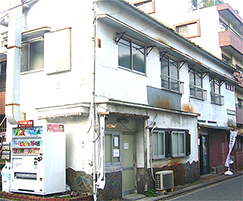 |
|
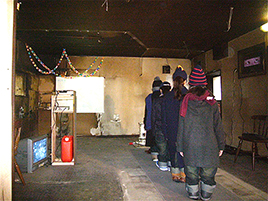 |
|
|
|
Exterior of Mitaka Apartments No. 1, the vacant building temporarily occupied by installations by Taro Izumi and Yuji Ohta. |
|
Taro Izumi's multimedia installation "A Kokeshi Doll Can't Climb a Mountain Alone," filling the ground floor of Mitaka Apartments No. 1 with detritus, video monitors showing more detritus, and doll-like performers. |
An adjacent room in the same building offered an amusing contrast in applications. Yuji Ohta's installation Moon Assets Video Presentation was a flawlessly executed parody of a typical investment scam, in this case for real estate on the moon. Entering the spartan but clean (astonishingly so, considering the chaos next door) and well-lit space, one was met by two impeccably-dressed young women passing out slick brochures full of charts, pretty photos, and persuasive drivel about can't-miss opportunities. One was then treated to an equally plausible video in which Ohta, clad in a suit in his role as "CEO of the Y.O. Group," did a deadpan, spot-on impersonation of a con artist selling the space-age equivalent of the Brooklyn Bridge. You can see the online component of his installation here.
|
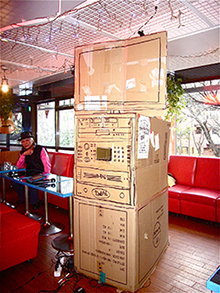 |
|
|
|
Tetsushi Higashino's "Karaoke Machine on the Floor," from which the artist provides impromptu accompaniment to songs sung by visitors at Restaurant Uwatoko, run by "The Worst Singer in Japan." Co-proprietor Saburo Uwatoko sits in the background.
|
The bona fide establishments that hosted some Teratotera events were no less fascinating. Close by the station is Restaurant Uwatoko, a karaoke bar run by a beguilingly eccentric older couple. Saburo Uwatoko cooks and tends bar while his wife Keiko, who bills herself as "The Worst Singer in Japan" (and claims to have patented the title), holds court with their singing customers. Inspired by Keiko's persona and, perhaps, the shocking-pink decor, installation artist Tetsushi Higashino built a cardboard karaoke box in which he hid while patrons warbled hit tunes of their choice to the accompaniment of the bar's real machine. The catch was that the soundtrack was distorted beyond recognition, and as one sang, all one heard was Higashino, emitting a nonstop stream of percussive noises and incomprehensible babble. I can testify that the experience was a vast improvement over listening to off-key drunks butcher "My Way."
One of the festival's highlights was an afternoon concert by sound adventurists Koichi Makigami and Jim O'Rourke, both active figures in Tokyo's thriving improvisational music milieu. O'Rourke unleashed a blizzard of electronic noise from a tabletopful of curious devices while Makigami, who calls himself a "pseudo-Kabuki vocalist," contributed unearthly sounds on voice, shakuhachi, jaw harp, and theremin. Adding a sublimely different flavor to a performance one might ordinarily hear in a downtown free-improv club was the venue: a judo dojo. The audience sat on wrestling mats, and Makigami and O'Rourke performed before a backdrop of calligraphy, a photo of the dojo's founder in judo regalia, and a rising-sun flag. The acoustics were excellent.
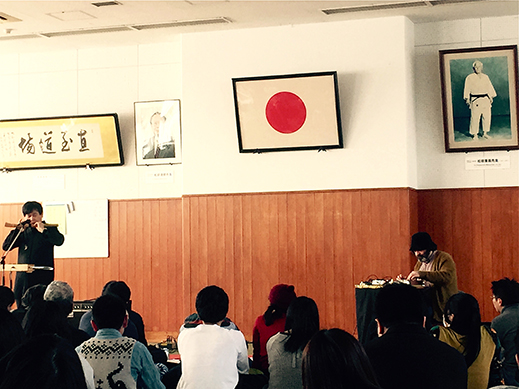 |
|
Koichi Makigami (left) and Jim O'Rourke (right) collaborate on decidedly un-martial music beneath the Rising Sun in a second-floor judo gym. |
|
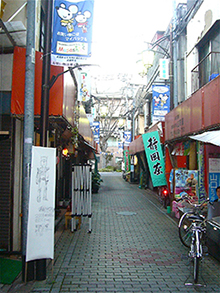 |
|
|
|
Midoricho Ichibangai, site of the Midorimachi Hikarimachi art festival organized by students from Musashino Art University.
All photos by Alan Gleason
|
Though Teratotera may not work its quirky magic on Mitaka again till next year, another, smaller but no less intrepid art event is in progress right now about a mile north of the station at Midoricho Ichibangai. This short block of old shops -- once thriving, but now mostly shuttered -- has been taken over for two weeks by Midoricho Muchu Lounge, a group of students from Musashino Art University (Musabi). Titled Midorimachi Hikarimachi (Town of Green, Town of Light), this mini-festival runs until March 14 and offers a mix of art installations in empty storefronts, live music, candlelight strolls, and other events for participants of all ages. Located in a neighborhood with many young children and senior residents, it is injecting a bit of life into a still-charming shopping district that has seen better days, and deserves to see more.
 |
|
| |
20 - 22 February 2015 |
|
|
|
| |
 |
Alan Gleason
Alan Gleason is a translator, editor and writer based in Tokyo, where he has lived for 28 years. In addition to writing about the Japanese art scene he has edited and translated works on Japanese theater (from kabuki to the avant-garde) and music (both traditional and contemporary). |
|
|
|
|